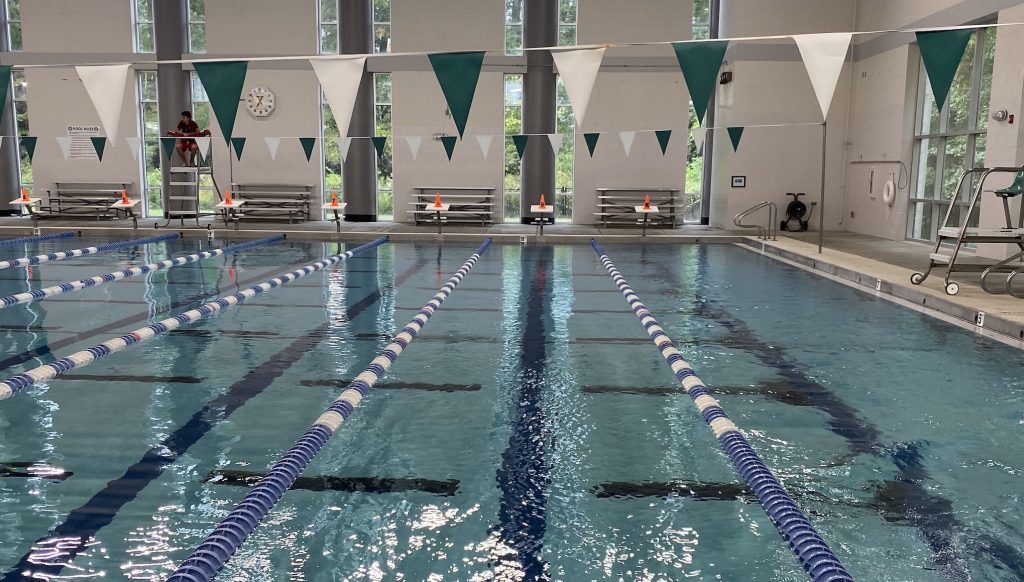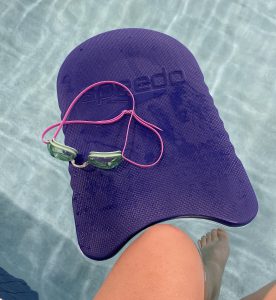One of the evidence-based strategies for diabetes prevention is achieving 150 minutes of moderate activity each week. I have recently decided to re-engage with an aerobic activity from my youth, swimming. Swimming is a great low-impact workout and I find it extremely meditative. I love the feeling of being immersed in cool water and the repetition of swimming laps. For me, swimming is the only form of physical activity that can melt away the stresses of the day.
Over the past several years, I haven’t had regular access to a pool and have significantly lost my lap swimming speed and endurance. I want to share how to get a swimming routine started (or in my case, reestablished) and hopefully inspire a few of you to swim some laps!

Swimming Benefits:
- Full body workout
- Increases your heart rate without stressing your body
- Tones muscle
- Builds strength
- De-stresses and relaxes
- Helps maintain a healthy weight, healthy heart and lungs
- Appropriate exercise for people with injuries, arthritis, and other conditions
How to Get Started:
You will need to locate a pool near you. Many gyms and community centers offer lap swimming times. It is a good idea to check out a few facilities in your area to determine which one works for your budget and lifestyle. Swimming takes a little coordination. If you are totally new to swimming it may be beneficial to look into swimming lessons. You will learn the different strokes and breathing techniques to help you get the most from your workout.
Gear:
Just like any other physical activity, you will need to have the appropriate gear to participate. Initially, I recommend keeping the gear very simple. Start with goggles, a swimsuit, and maybe a swim cap.

- Goggles (Review of Best Swim Goggles for Adults and Kids)
- Swimsuit (I recommend checking out SwimOutlet for finding deals on swimsuits. Ladies, check out this review of suits for women.)
Optional Gear:
- Swim Cap (optional…depends on your hair length. I prefer the silicone caps over latex versions because they are better quality and pull your hair less)
- Kickboard and a pull-buoy (most facilities will have these on hand)
- Waterproof watch (helpful for timing interval workouts)
- Lock for your locker (A good idea for public pools to secure your belongings)
Ease into a regular routine:
Consistency is the key to learning anything. Start with 10 swim sessions of easy, steady swimming over a three-week period. After those first three weeks, you should feel your body begin to adapt to the activity. In each of these sessions, swim for as long as you can, resting as much as you need. Aim for at least 20 minutes sessions. Don’t get discouraged if you get winded quickly, your body is adapting to a new activity.
Once you have a handle on the basics, try swimming laps for 20 to 40 minutes at a pace that keeps your heart rate elevated. ***Remember to drink plenty of water and take breaks (just because you are submerged in water doesn’t mean you can’t get dehydrated).
Be aware of lane etiquette:
Familiarize yourself with the facility’s rules for sharing lap lanes. When three or more swimmers are sharing a lane, typically facilities will ask you to do “circle-swimming”. When you are circle-swimming, you go up on one side of the lane and return on the other (similar to driving a car). I don’t mind sharing a lane, but I prefer having a lane to myself. I will ask the staff what times are the lap lanes the least busy and schedule my workouts around those times.
Example of a Beginner Swim Workout: 750 yards
- 100 yards (4 lengths): Warm up.
- 50 yards (2 lengths): Flutter kick on side. Lie on one side with lower arm extended, ear resting on arm, upper arm along body; hold on to a board with top hand if necessary. Kick from hips (not knees), looking up and keeping knees and side or back of head in water.
- 50 yards: Flutter kick with kickboard (keep head in water and breathe to both sides).
- 5 x 50 yards: Swim at a moderate to hard intensity for 5 laps, taking a breath every 3 strokes. Take 50 to 60 seconds to swim each lap, resting at the wall if you have extra time.
- 2 x 50 yards: Swim easy for 2 laps, taking 1 to 1:15 minutes to swim each lap.
- 100 yards: Swim at a moderate intensity.
- 100 yards: Cool down at an easy swimming workout pace.
Other Helpful Resources:
- Starting a Swimming Routine
- How to Swim Laps for Exercise
- 5 Basic Skills in Swimming
- Beginner Swimming Workouts
If you have any swimming advice, share below in the comments!
Don’t miss another great blog: Subscribe Now

The speed recommendations may be too ambitious for the more mature, out of shape, or average swimmer.
Hi Sam, thanks for your feedback. We would recommend adapting any workout to your own needs.
This article is great ! Swimming in the Winter is a great way to stay fit and keep the cold weather blues away: it always keeps me in a Summer mindset !
The benefits of swimming year round also include the fact that your body gets used to temperature differentials and thus keeping circulation strong and the body more adaptable to extreme weather fluctuations.
We agree, Francis! It’s a great year-round form of exercise for any age and any fitness level! 🙂